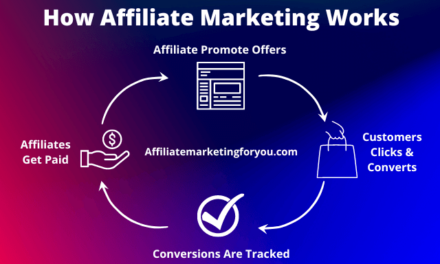Before you can create your affiliate website, you must first explore the affiliate programs that are accessible. Most applications will offer a directory that you may browse by subject to see all of the goods that are available. There are numerous affiliate networks to choose from but it’s a very important step to find the Right Affiliate Program that is suitable for your niche to run a Succesful Affiliate Marketing Business. Here are a few examples:
ClickBank.com —This is one of the most famous retail marketplaces for selling digital products such as eBooks or software. There are thousands of ebooks available in a variety of categories, including Computers/Internet, Software & Services, Arts & Entertainment, Health & Fitness, Business/Investing, Games, Cooking/Foods, Parenting, and Politics, among others. Many of these books are written in a “how-to” format. They instruct you on how to do something or how to solve a certain problem.
Because software and eBooks have no manufacturing costs per item, commissions might be huge. On these products, you can expect to earn 50-70 percent commission. You may make money on ClickBank in two ways.
Build your own products and sell them. To list your products, you must first create a vendor account. You set the price of your product and the commission you’ll pay an affiliate to sell it. If you have an excellent product, you may attract a large number of affiliates who wish to market it. You don’t have to be concerned about all of those accounts. ClickBank automatically credits the appropriate amount to the affiliate account. The remainder is then credited to your account.
- Work as an affiliate to promote products. You might not be able or have the time to create dynamic eBooks. You may possibly lack the necessary resources to manage everything. You may still make money by recommending things already listed in its marketplace, and you don’t have to do any effort.
When you visit ClickBank, you’ll see certain statistics in their affiliate program listings. Here are a handful of the terms you’ll come across on the site, along with their definitions:
- Initial $/sale—This is the amount you make on each sale.
- Avg %/sale—This tells you what proportion of the sale price you’ll get.
- Avg Rebill Total—If the product has recurring billing, such as monthly membership fees, this is the amount you might expect in addition to the initial transaction.
- Avg %/Rebill—This amount will only be displayed, if the specific seller offers products with recurring billing. It shows you the average commission rate that can be earned for that amount of money.
- Grav—This indicates how “hot” the product is right now. If the gravity is high, it indicates that a large number of affiliates are successfully selling that product. If it has low gravity, it means there are fewer affiliates selling it. In general, you should choose products with a high level of affiliate activity.
It is a very simple process to sign up for ClickBank. Everything that you should do is click the “Sign Up” button. You’ll find it at the top of the page. Simply provide the required information and click “Submit.” It will offer you guidance on what to do next. When you’ve signed up and have your own ClickBank ID, you’ll be able to find any product on the network that you want to advertise.
Take a look at the products. When you identify the one you wish to promote, simply click the “Promote” button. They’ll ask for your identification. The site will generate your HopLink, which is your affiliate link, once you provide it. When you’re exploring products, you’ll see a “Promote” button. Without this link, you will not be credited for any purchases made by your visitors.
Commission Junction Marketplace—Advertisers can reach a large number of people with this network. It also provides a lot of money to publishers. It provides publishers and advertisers who participate with a mechanism to access information, analyze results, and manage their programs for success. Here’s how it works for each of them:
- Advertisers—CJ Marketplace reporting tools can be used for a variety of purposes, including creating a call to action, defining program parameters, examining publisher applications, and analyzing program performance. They also have an online resource, CJU Online, where you can study tactics, interact with publishers, and stay up to date on industry news.
- Publishers—You can apply to join programs and gain access to the entire link inventory. Then you may start putting offers on your website, sending them in e-mail campaigns, or listing them in search results.
There are additional methods for locating affiliate programs that do not function through affiliate networks. These will not appear in the directories. Finding out about them can be a little more complicated. If you hear of one, you may always email the seller and ask for further information.
You might come across software that indicates “Invite Only.” These sites typically restrict entry by either admitting only persons who have purchased their goods or by reviewing and approving people on an individual basis.
5 EFFICIENT STRATEGIES TO PROMOTE AFFILIATES PRODUCTS
Review the product/service you are promoting—When you start promoting your products/services, you should write a review for each one. A review is typically one page long and includes the following information:
- Product, service, or website name
- Description—A brief description of the product, service, or website
- Availability—Where the products can be purchased or accessed
- Pros—What makes you feel good about the product
- Cons—What you don’t like about the product
- Price—Do you think the price is reasonable, too high, or too low?
- Recommendation—Why or why not would you recommend this product, and to whom would you suggest it?
- Additional comments
- Contact information—Inform them of the product, service, and website owner’s contact details.
If you want to try out the products and subsequently evaluate them on your blog, there are two options:
- Join a blog review network—Simply fill out a form with information about yourself and your blog. You will then receive review invitations. You get to choose which ones you accept and which ones you reject. If you accept the invitation, you will normally receive a product that is yours to keep. You use it and then write a review about it. In addition to the product, you may receive some form of monetary compensation, such as a gift card or a sweepstakes entry.
A few networks you may want to consider are:
- Sponsored Reviews — Sponsored Reviews can be used to attract customers who will write unbiased product reviews. They will receive monetary compensation as an incentive.
- Prizey—If you sign up as a free member, you may be able to connect with a marketing or PR company.
- MomSelect —A review network for bloggers and non-bloggers alike.
The disadvantage of blog networks is that you cannot choose the invitations you get. You might be interested in technology, and your blog might be about it. You want to find good products to become an affiliate with, and you want to try them out first to ensure that they are of high quality, but you might get invitations to sell dish detergent or shampoo instead. Of course, you can decline, but agreeing and conducting reviews for them gives you a fantastic opportunity to practice writing evaluations for the goods with which you do want to become an affiliate. They also contribute to the expansion of your audience, which is critical. This is an excellent approach for novice bloggers to begin driving traffic to their sites.
- Ask for them—Identify the business with which you want to work as an affiliate. Inquire if they’d be interested in providing you with a product to review and perhaps promote on your blog. Tell them about yourself and your blog. It will take some effort to structure your query so that it is clear and persuasive, but the effort will be worthwhile once completed.
Make certain that every product you accept is one you believe you can stand behind. In other words, if you would never pay $100 for a pair of pants, don’t accept the invitation. It will be tough to persuade someone else to buy them. If you wanted to become an affiliate, it would also be tough to advertise them on your site.
Create video tutorials on how the product/service works—Video tutorials are excellent for explaining “how-to” topics. You may teach your audience how to accomplish something, and they will receive a beautiful image that will help them comprehend how a product/service works.
Here are the steps you should take to create an effective video tutorial:
- Write a script—Choose a topic or a short activity that you can describe briefly. Because videos should ideally be no more than three minutes long and no more than five minutes long, you should keep them around 300 words. Make the script as conversational as possible. Read it several times and walk through the steps you want to demonstrate to your audience. Having your script displayed on a monitor, with the locations where you will do an action underlined, can help you keep focused and on track during the video.
- Prepare a simulation—Determine the type of information, event, or other tasks you wish to display and run it through. Check that it works and that you can demonstrate it in a straightforward manner. Practice it a few times to ensure that your actions correspond to your script.
- Record the simulation and narration—Ideally, this is done in three steps:
On one display, record your script, and on another, record the simulation. Don’t be concerned if you find yourself veering somewhat from your script. It happens when you’re trying to be communicative, and it’s perfectly normal. Try to keep your speech normal while concentrating on the simulation. You’ll get a clean, fluid screen motion. If you’re playing a computer simulation, avoid using a touchpad mouse. Jerky motions are possible. Use a conventional mouse instead, and drag it smoothly. When you’re talking, avoid moving the mouse around because it makes editing tough.
- Record the audio again—You must first isolate the audio from the video. Then reread your script. Make sure you pause where necessary. When doing this type of voiceover, try to be careful of things like adjusting the tone of your voice, avoiding repetitious rhymes, enunciating, speaking clearly and confidently, and varying the pace of your speech to sound as natural as possible.
- Match the timing—After you’ve recorded the audio again, play both tracks at the same time. Coordinate the timing. Don’t be concerned if your pauses don’t exactly match up. You can close the gap between audio waves by adjusting the spacing between them.
- Simulation post-processing—Check the audio and simulation to remove any unnecessary long pauses or instances of inaction. You can use callouts to draw attention to whatever you want to display on the screen. Give your video a title slide that lasts roughly two seconds. Make sure it specifies the video’s topic. As you fade out the title, fade in your recording.
The options for callouts, annotations, and animation will vary depending on the software you’re using. Just keep things as straightforward as possible. The larger the file length of your video, the more you add to it. The larger the file size, the longer it will take to create. If you wish to incorporate a music track, go to istockaudio.com and look for a loop or sting.
- Publish and integrate the video—Convert the video to MP4 format. After that, post it to your server. If you upload it to YouTube, it will automatically be rendered in high definition. When you select HD, any text you use will be clear and not blurry. YouTube also features voice recognition software that syncs your caption with the voice. Simply enter the script into the captions section. The auto-sync tool enables non-native speakers and individuals with hearing difficulties to understand what your video is saying. Search engine optimization is also getting a boost.
Recommend it on your Site or Blog—You want as many people to see the tutorial as possible once you’ve developed it. Keep in mind that you want high-quality material. If your audience is interested and excited, they will return to your site more frequently and for a longer period of time.
When selecting products, it is critical to remember the quality rule. Many bloggers do not appear to choose their products based on their quality. They just push whatever they want. At times, they may be marketing high-quality items, but they don’t appear to care how they do so. They never utilize a new approach to product promotion. You should give the vendor some attention. They are concerned about their customers and their reputation. Poor product advertising does not reflect well on them.
That’s one of the reasons video tutorials are so popular. They provide your viewers with a fresh perspective on an old product or the first look at a new product. When you supply your audience with material that they find beneficial, you assist to create trust with them.
Social media—If you’re seeking for a powerful medium to interact with the masses, look no further than social media. All affiliate marketers must reach out to a large number of consumers. Social media platforms can assist you with this. Affiliate marketers can benefit greatly from the use of social media. Social media websites such as Facebook, LinkedIn, Instagram, TikTok, and Twitter allow you to connect with individuals from all walks of life and share your thoughts with them.
There are various things you can do on social media to assist your affiliate marketing strategy successfully. They are as follows:
- Promotion of the affiliate programs—Once you’ve established your own followers, those on your friend’s list will be able to share all of your posts and links. Posts and blog articles on your page can be used to market the products for which you are an affiliate. Fan pages can also be built, which will help to increase your promotion.
- Bond with your audience—You can expand your contact list by adding folks who will appreciate what you have to say. You will have greater coordination with your audience if you create interactive groups. After you’ve shared information about your affiliate products with the audience, solicit comments from them. Feedback can be useful in both strengthening bonds with your audience and assisting you in making necessary changes to your strategy. Inform them about your affiliate products and solicit comments.
- Stay up-to-date—You’ll want to stay up to date on what’s going on in your market. You can learn about all of the new product launches and which ones the market appears to like by using social media. This will allow you to stay up to date on current trends and fine-tune your affiliate advertising strategies in the appropriate way.
Because you will not be the only affiliate marketer out there, the competition to make your strategy effective is intense. Here are a few pointers to assist you to gain a competitive advantage on social networking sites:
- Focus on relationships—Social media platforms include Facebook, Google+, and Twitter. “Social” is the crucial word here. Make sure you connect with the correct people and develop a relationship with them. Try having a fan page with zero followers. This will assist you in learning more. Promoting your business will be easier if you have a good, strong relationship with your target clients. They’ll want to share what you’ve said to their followers on their page.
- Add social bookmarking—A social bookmarking button can be added to your website. Then, invite your visitors to join you. In this manner, if visitors to your posts like them, it will be simple for them to share them. There will be no cost to use social bookmarking, so make use of it.
- Blog smarter…not harder—Some bloggers work extremely hard and spend hours upon hours preparing blogs that are rarely read. Blog smartly when generating blog articles for your website. The primary goal should be to capture the visitor’s attention. Once you’ve done so, provide them with informative, precise information that they’ll find useful. Your social media profile will improve if you do this.
Increasing your web presence is fundamental, and these strategies will assist you in doing so. You’ll find it easier to find and reach out to potential clients once you’ve mastered social media. Once you’ve decided on the correct products/services to promote, simply be truthful with your potential customers. If you do, you will be able to win their hearts through social media.
Email list—Many bloggers do not believe they can generate money from email marketing, so they do not use it. They are blind to the benefits. They just don’t think it’s worth their time, so they don’t try. Just like a new restaurant, if you really do not test it, you won’t know what it’s like. You might be losing out on something incredible.
As a marketer, there are some things you don’t want to miss for fear of making a mistake later on. Before you begin your email marketing campaign, there are a few things you should be aware of:
- Build your subscriber’s list—The money is in the list. You want to have as many subscribers on your list as feasible. You’d get traffic to your email if it were a blog. Your subscribers are your traffic in email marketing. The more traffic your blog receives, the better the outcomes. The same is applicable to email and subscriptions. The more you have, the better the results will be.
- Be original—Many people that use email marketing fail to be creative in their communications. This is one of the most effective strategies to convert subscribers into unsubscribers. People will unsubscribe in a hurry if they don’t believe your emails include original, relevant information. They don’t want their email to be overflooded with spam.
- Write to prove you’re familiar with what you’re promoting—Nothing is worse than a “canned” review scraped from ad copy. Readers want to believe you understand what you’re talking about. They’re searching for a personal touch that demonstrates your knowledge of the product. If possible, request and use the product first. This provides you with firsthand information to share with your reader. You’ll be better able to address any inquiries your readers may have regarding the products this way.
- Write honest reviews—Every item you review will not be “great.” Some of them will probably be “average.” Whatever the matter may be, simply state it. You can assign a basic number rating to your evaluations, such as 1—2—3—4—5. However, make sure to give it the rating you believe it is worth.
Don’t use too many links—Links are important, and you should use them, but having five links in the first paragraph on the same keyword is useless. You can reduce the number of links you use if you are more creative and successful with them. As an example: Have custom-made graphical banners that say things such, as “Learn more about the product,” “View the product,” or “Check out my review.” These inform the reader exactly what they will receive at the other end of the link. These catch the reader’s attention and stimulate their interest in the product.











